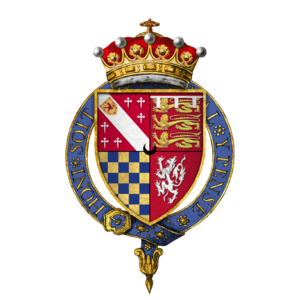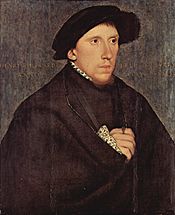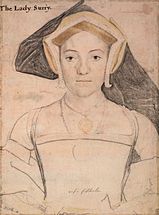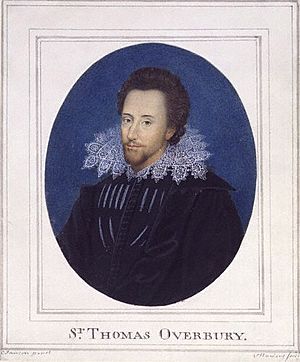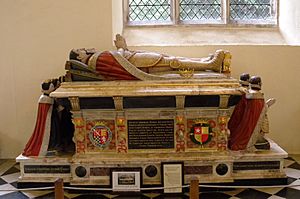Henry Howard, 1st Earl of Northampton facts for kids
Quick facts for kids
The Earl of Northampton
|
|
|---|---|
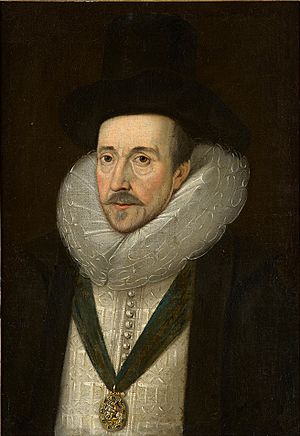
Henry Howard, Lord Warden of the Cinque Ports, since 1 January 1604 and Earl of Northampton since 13 March 1604
|
|
| First Lord of the Treasury | |
| In office 1612–1613 |
|
| Preceded by | The Earl of Salisbury |
| Succeeded by | The Viscount Brackley |
| Lord Privy Seal | |
| In office 1612–1613 |
|
| Preceded by | The Earl of Salisbury |
| Succeeded by | The Earl of Somerset |
| Personal details | |
| Born | 25 February 1540 Shotesham, Norfolk, England |
| Died | 15 June 1614 (aged 74) Charing Cross, London, England |
| Parents | Henry Howard, Earl of Surrey Frances de Vere |
| Religion | Roman Catholicism |
Henry Howard, 1st Earl of Northampton (born February 25, 1540 – died June 15, 1614) was an important English nobleman and advisor to the king. He was known for being very smart and cultured. He also supported many public charities.
Henry Howard built famous buildings like Northumberland House in London. He also helped build Audley End, a beautiful house. He even started several hospitals to help people. After he passed away, it was found that he was involved in a big scandal.
Contents
Early Life and Education
Henry Howard was born in Shottesham, Norfolk, England. This was on February 25, 1540. He was the third of five children. His parents were Henry Howard, Earl of Surrey and Frances de Vere.
His family had different religious views. His mother's family supported the Reformation. His father's family were mostly Roman Catholic.
Henry's father, the Earl of Surrey, faced serious trouble. King Henry VIII believed he was planning to take the throne. His father was executed in 1547. Henry's grandfather was also sent to the Tower of London.
After his father's death, Henry and his siblings were cared for by their aunt. They had a Protestant tutor named John Foxe. He taught them Greek and Latin. They became very learned. Even though they had a Protestant tutor, Henry and his siblings remained Catholic.
When Queen Mary I became queen, his grandfather was freed. Henry and his older brother then studied with John White. He was the Bishop of Lincoln. Henry studied philosophy, law, and history.
After Queen Mary died, Queen Elizabeth I helped with Henry's education. He went to King's College, Cambridge. He earned a master's degree in 1564. He also studied at Trinity Hall, Cambridge.
Facing Challenges
In 1568, Henry told Lord Burghley that people wrongly suspected his religious beliefs. He wrote a book on philosophy for his younger sister, Katherine. She helped him during difficult times.
Around 1570, Henry came to the royal court. But his brother, the Duke of Norfolk, was suspected of plotting. This made things harder for Henry. In 1572, his brother was accused of planning to marry Mary, Queen of Scots. Henry was arrested too.
He proved his innocence to Queen Elizabeth. He was allowed back at court. He also received a yearly payment. However, many people thought he had caused his brother's downfall.
After his brother was executed, Henry went to Audley End. He took care of his nephews and niece. He wrote many letters to important people. He wanted to stay in the queen's good graces. He also gave political information to Mary, Queen of Scots.
In 1582, he was arrested again. This was because his cousin accused him of heresy. Henry admitted he had attended Catholic services. But he denied any treason. He was soon released. He then wrote a book against judicial astrology.
In 1583, Henry was sent to the Fleet Prison. This was after a plot was discovered. He complained about how he was treated. He was later allowed to stay at Sir Nicholas Bacon's house. He had very little money at this time.
Rising to Power Under James I
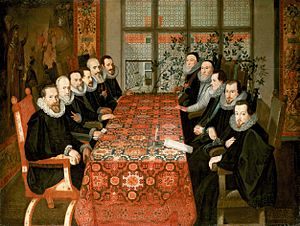
Towards the end of Queen Elizabeth's rule, Henry became close to Robert Cecil. He also connected with James VI, who was the King of Scotland. James was next in line for the English throne. James sent Henry a valuable jewel. Henry sent James long letters with advice.
When James became King of England in 1603, Henry received many rewards. He helped his great-nephew, Thomas Howard, regain his family's titles and lands. Thomas's family had faced difficulties because they were Catholic.
In 1603, Henry became a Privy Counsellor. This meant he was a trusted advisor to the king. In 1604, he became Lord Warden of the Cinque Ports. On March 13, 1604, he was made Earl of Northampton. He also became a Knight of the Garter in 1605. Later, he was appointed Lord Privy Seal.
He was also a judge in important trials. He helped create a peace treaty with Spain in 1604. From Spain, he received a yearly payment. In 1610, he received land in Newfoundland. He also became Chancellor of the University of Cambridge in 1612.
The Overbury Scandal
Henry Howard was involved in a major scandal. This involved his great-niece, Lady Essex. She wanted to divorce her husband to marry Somerset. Henry helped her with the divorce process.
However, Somerset's friend, Sir Thomas Overbury, tried to stop the marriage. Henry then helped arrange for Overbury to be imprisoned in the Tower of London. A friend of Henry's family was put in charge of the Tower.
Overbury died in September 1613. After Henry Howard himself passed away, an investigation took place. It was discovered that Overbury had died from poison. The scandal connected Henry to the events surrounding Overbury's death.
Final Years
Months before he died, Henry Howard moved his father's remains. They were moved from London to St Michael the Archangel's Church, Framlingham. Henry ordered a beautiful tomb to be built there. It was for his parents. His mother's remains were also placed in this new tomb.
Henry Howard died on June 15, 1614. He was never married. He was buried in the chapel of Dover Castle. His title as Earl of Northampton ended when he died.
Building Projects
Henry Howard expanded Greenwich Castle. He also built his London home, which later became Northumberland House. He oversaw the designs for Audley End, his nephew's home.
He also planned and funded three hospitals. These were Trinity Hospital at Clun, Trinity Hospital at Castle Rising, and Trinity Hospital at Greenwich. The Greenwich hospital was for poor people from Greenwich and his birthplace, Shottesham. He laid the first stone for the Greenwich college in 1614.
Images for kids
-
Thomas Howard, 3rd Duke of Norfolk, Henry's paternal grandfather
-
John de Vere, 15th Earl of Oxford, Henry's maternal grandfather


